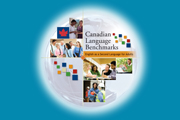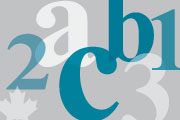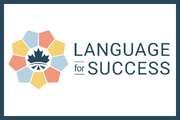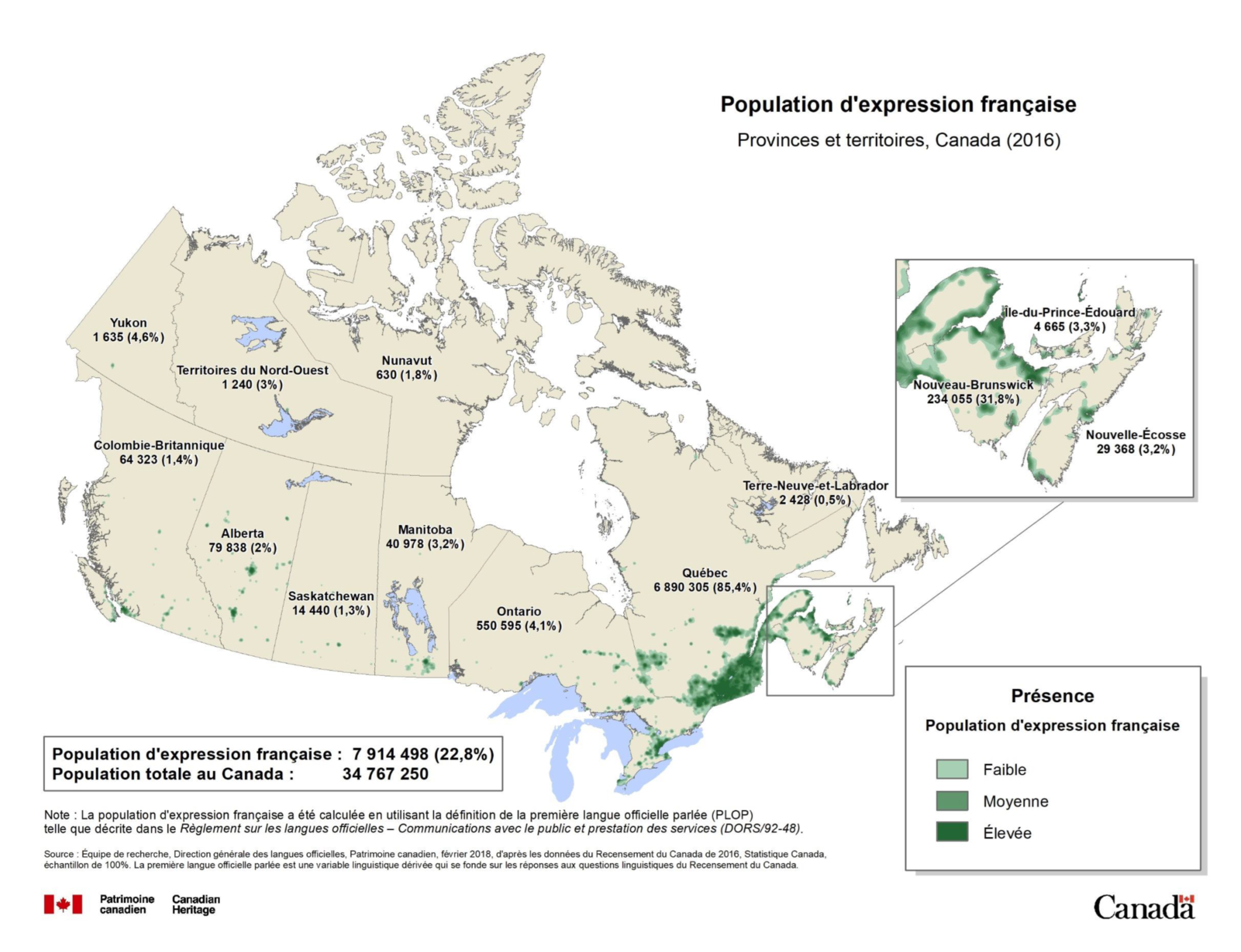Francophonie in assessment centres
Canadian Francophonie:
- Canada has a population of nearly 35 million people.
- 22.8% consider French to be the first official language spoken.
- 85.4% of Francophones live in Quebec.
- 2.7 million live in the other Canadian provinces and territories.
- 10.4 million Canadians can hold a conversation in French.
French-speaking population, provinces and territories, Canada (2016)
| Province or territory | Province or territory French-speaking population |
| Newfoundland and Labrador | 2,428 (0.5%) |
| Prince Edward Island | 4,665 (3.3%) |
| Nova Scotia | 29,368 (3.2%) |
| New Brunswick | 234,055 (31.8%) |
| Quebec | 6,890,305 (85.4%) |
| Ontario | 550,595 (4.1%) |
| Manitoba | 40,978 (3.2%) |
| Saskatchewan | 14,440 (1.3%) |
| Alberta | 79,838 (2%) |
| British Columbia | 64,323 (1.4%) |
| Yukon | 1,635 (4.6%) |
| Northwest Territories | 1,240 (3%) |
| Nunavut | 630 (1.8%) |
| Total | 7,914,498 (22.8%) |
| Total population in Canada | 34,767,250 |
Why learn French in Canada
As one of Canada’s two official languages, French is second only to English in Canada.
Learning French in Canada has major benefits. It can help you:
- Understand Canadian history and Franco-Canadian culture.
- Expand your professional and economic opportunities.
- Increase your chances of studying in French-language universities/colleges.
- Communicate with the Francophone population when travelling throughout Canada
- Have access to more information and resources in French.
- Open up to the French-speaking world through French literature, film, music, etc.
- Support your children’s schooling and help them with their French homework.
Providing French services at assessment centres in Francophone minority communities:
Classified as one of Canada’s two official languages, French is spoken by 10 million Canadians, the majority of whom live in the province of Quebec. However, more than 2.7 million Francophones are spread across Canada’s provinces and territories and live in minority communities. These French-speaking clients in minority situations often face countless challenges due to language barriers and unequal access to services in the country’s two official languages when trying to access services outside of their Francophone communities.
Language assessment centres are among the institutions best positioned to promote French because they are in frequent contact with newcomers. They also play a prominent role in promoting the services offered by community organizations. Despite this obvious advantage in helping ensure the linguistic security of French, language assessment centres are not only unevenly distributed across the country, they are often criticized for deficiencies in service quality and in the type of services they actively offer.
Francophone clients in minority situations are constantly sounding the alarm. In fact, they experience this situation firsthand when they visit language assessment centres. Even though they claim the right to access services in the official language of their choice, they often conceal their linguistic identity. They use this strategy out of fear of not receiving service as quickly or out of a belief that it is pointless to request services in French in a minority context because they are unavailable or of inferior quality. (Source: Client survey).
In light of the above, in order to better meet the language needs of Francophone minority clients, it is essential that language assessment centres take all of these issues into account in their service management planning. Suitable measures must also be put in place to ensure the equitable delivery of quality French language services in order to:
- Maintain quality communication between language assessment centre staff and Francophone clients in the preferred official language of the client
- Ensure a clear understanding of the service provided
- Promote community services to Francophone clients
- Increase the overall level of satisfaction with the service provided by the language assessment centres
- Increase access to French language services outside of Quebec.
Suggestions for promoting French services at assessment centres in Francophone minority communities:
In order to promote and expand the availability, equity and quality of French language services in language assessment centres, the centres should take a more proactive role in offering French language services by following the recommendations below:
Increase consistency and equitable use of both official languages wherever possible (on the phone, voice mail) in administration, reception, website translation, etc…
- Identify French-speaking staff within your team
- Encourage a strategy to recruit bilingual staff or volunteers.
- Provide visual resources (posters, pins, etc.) in both official languages.
- Encourage the use of French in social media.
- Identify French-speaking clients and offer service in their preferred language.
- Share community resources in French to promote the active offer of services in French.
Process for identifying Francophone clients:
The results of the 2021 client survey clearly show that in minority areas, Francophone clients would often hide their linguistic identity when speaking to staff for fear of not receiving service.
In this case, how do we identify French-speaking clients?
Ask the following question:
What is your first language?
- French
- English
- Other
If the answer is ”other” ask the following question:
In which of Canada’s official languages are you most comfortable?
- French
- English
Canadian Francophone organizations and associations:
Office of the Commissioner of Official Languages: https://www.clo-ocol.gc.ca/splashify-splash
Institut de recherche sur le français en Amérique (IRFA): https://www.irfa.ca/site/
Language Portal of Canada: https://www.noslangues-ourlanguages.gc.ca/fr/index
Centre de la francophonie en Amérique https://francophoniedesameriques.com/
Canadian Association for French Language Education: https://acelf.ca/
Fédération des communautés francophones et acadiennes (FCFA): https://fcfa.ca/
Centre for Research in French-Canadian Culture (CRCCF): https://arts.uottawa.ca/crccf/
Alliance des femmes de la Francophonie canadienne (AFFC): https://affc.ca/
Provincial associations:
Alberta: Association canadienne-française de l’Alberta (ACFA) https://acfa.ab.ca/index-main/
British Columbia: Fédération des francophones de la Colombie-Britannique https://www.lacolombiebritannique.ca/
Prince Edward Island: Société Saint-Thomas d’Aquin https://www.ssta.org/
Manitoba: Société de la francophonie manitobaine https://rifmb.ca/sfm/
New Brunswick: Société de l’Acadie du Nouveau-Brunswick https://www.sanb.ca/
Nova Scotia: Fédération acadienne de la Nouvelle-Écosse https://www.acadiene.ca/
Ontario: Assemblé de la francophonie en Ontario: https://monassemblee.ca/
Saskatchewan : Assemblée communautaire fransaskoise https://www.fransaskois.sk.ca/
Newfoundland and Labrador : Fédération des francophones de Terre-Neuve-et-Labrador https://www.francotnl.ca/
Northwest Territories: Fédération franco-ténoise https://www.federationfrancotenoise.com/
Yukon: Association franco-yukonaise http://www.afy.yk.ca/secteurs/main/fr/index.php?site=afy
Nunavut: Association des francophones du Nunavut https://www.afnunavut.ca/
*Non-exhaustive lists.
Resources and continuing education for assessors
Continuing Education for CLBPT assessors
CCLB offers exemplars and other resources relevant to CLBPT assessors on the testing.language.ca training platform under CLBPT resources and continuing education for assessors.
Tests and tools offered by CCLB
Canadian Language Benchmark Placement Test (CLBPT)
Description: The CLBPT is a pan-Canadian assessment instrument based on the national framework of the Canadian Language Benchmarks (CLB). The CLBPT measures the four language skills, namely listening, speaking, reading and writing, according to CLB levels 1 to 8.
Usage: The CLBPT is designed to effectively determine the language proficiency level of newcomers, immigrants or any adult learner who wishes to enroll in a LINC or ESL program. The CLBPT allows Anglophone organizations and LINC or ESL programs to better determine the language needs of their learners and to suggest the program that best suits their needs.
This test is low stakes and cannot be used for employment, academic, immigration or citizenship purposes.
Type of clientele: Adult newcomers (18 years and older) to Canada who wish to take government funded LINC or ESL courses.
This test is offered in English only, but an equivalent French version is available (BTC-NCLC).
Click here to see the centers that offer this test.
For more information about CLBPT Assessor Training, click here.
Proctor-less CLBPT Remote assessment provides a viable alternative to face-to-face administrations for situations such as COVID-19, or for regions without an assessment centre as well as remote locations. The “remote” version of the CLBPT reduces the waiting time for clients to be assessed. Remote assessment has resulted in clients who live in areas without an assessment centre having the opportunity to access assessment and placement into a language program much quicker than if they had to wait for an itinerant assessment.
The assessment is suitable for clients with at least basic computer skills. The client must know how to copy-paste information and log into a website and register. The Reading test requires use of a mouse to click the correct answers. The written test requires keyboarding skills. The Listening-Speaking assessment requires basic computer skills such as connecting with the assessor through Zoom and adjusting their computer volume as needed.
CLBPT license cancellation
If your site no longer conducts CLBPT assessments, you have to inform CCLB immediately in writing to [email protected]. Once the CLBPT License cancellation has been made official, you/your site will be responsible to ensure that all CLBPT Kits or lose CLBPT materials are destroyed in a secure manner (i.e.: shredding). However, you will be expected to keep the test results of your clients on site for a period of at least 2 years after they were conducted (see section 4.6 of the CLBPT licensing agreement).
CLBPT materials
CLBPT Kits or any loose CLBPT materials should always be stored securely at the licensed site location. Assessors should not have their own kit or test materials with them unless they are conducting itinerant assessments. If an assessor conducts itinerant assessments, the test materials should be returned to the licensed site as soon as possible as per the license agreement with CCLB. The CLBPT Kits are the property of the assessment centre; if an assessor in your employ should resign, retire, or leave your centre for any other reason, the CLBPT Kit assigned to the individual MUST be returned to the centre.
Canadian Language Benchmarks: Literacy Placement Test (CLB-LPT)
Description: The 2018 CLB-LPT is an assessment that measures the reading and writing abilities of literacy learners in reference to levels described in the Canadian Language Benchmarks: ESL for Adult Literacy Learners (ALL) document. The results obtained with this tool provide information about the learner’s literacy skills in English.
Usage: CLB-LPT assessment results are to be used for the purpose of placing ESL literacy clients into appropriate programs and classes.
This test is low stakes and cannot be used for employment, academic, immigration or citizenship purposes.
Type of clientele: Adult newcomers (18 years and older) to Canada who wish to take government funded LINC or ESL courses and have shown literacy needs during their speaking and listening test (CLBPT).
This test is offered in English only, but an equivalent French version is available (BTC-AMA).
Click here to see the centers that offer this test.
For more information about CLB-LPT Assessor Training, email [email protected].
Batterie de tests de classement aux Niveaux de compétence linguistique canadiens (BTC-NCLC)
Description: The BTC-NCLC is a pan-Canadian assessment instrument based on the Niveaux de compétence linguistique canadiens (NCLC), français langue seconde (FLS) pour adultes. The BTC-NCLC measures the four language skills, namely listening, speaking, reading and writing, according to NCLC levels 1 to 8.
Usage: The BTC-NCLC is designed to effectively determine the language proficiency level of newcomers, immigrants or any adult learner who wishes to enroll in a CLIC or FSL program. It allows Francophone organizations and CLIC or FSL programs to better determine the language needs of their learners and to suggest the program that best suits their needs.
This test is low stakes and cannot be used for employment, academic, immigration or citizenship purposes.
Type of clientele: Adult newcomers (18 years and older) to Canada who wish to take government funded CLIC or FSL courses.
This test is offered in French only, but an equivalent English version is available (CLBPT).
Click here to see the centers that offer this test.
For more information about BTC-NCLC Assessor Training, click here.
Batterie de tests de classement pour adultes moins alphabétisés (BTC-AMA)
Description: The 2018 BTC-AMA is an assessment that measures the reading and writing abilities of literacy learners in reference to levels described in the Niveaux de compétence linguistique canadiens : Français langue seconde pour adultes moins alphabétisés (FLS pour AMA) document. The results obtained with this tool provide information about the learner’s literacy skills in French.
Usage: BTC-AMA assessment results are to be used for the purpose of placing FSL literacy clients into appropriate programs and classes.
This test is low stakes and cannot be used for employment, academic, immigration or citizenship purposes.
Type of clientele: Adult newcomers (18 years and older) to Canada who wish to take government funded CLIC or FSL courses and have shown literacy needs during their speaking and listening test (BTC-NCLC).
This test is offered in French only, but an equivalent English version is available (CLB-LPT).
Click here to see the centers that offer this test.
For more information about BTC-AMA Assessor Training, click here.
Workplace Language Assessment (WLA)
Description: The Workplace Language Assessment (WLA) is a Canadian Language Benchmark (CLB) assessment that measures listening, speaking, reading and writing skills from CLB 6 to CLB 10.
Usage: The WLA is designed to place ESL clients in higher-level language training programs that focus on preparing newcomers for the Canadian workforce or in bridge to employment programs. The WLA is a streamlined assessment that allows candidates to demonstrate their readiness for programs involving further language and work-related training. The WLA is an effective, reliable tool for measuring the language proficiency of internationally educated professionals.
The WLA should not be used for assessment at the end of a training program. It should also not be used to assess language for direct entry into the workplace, nor for assessing professionals seeking access into licensed professions.
Type of clientele: The WLA is designed for internationally educated professionals with work experience who are seeking employment in their field. They should have had English language training and exposure to English usage and have achieved an intermediate to advanced level of proficiency.
This test is available in English only.
CLB 5-10 Exit Assessment Tasks
Description: CLB 5-10 Exit Assessment Tasks allow facilitators to assess the language achievements of adult learners at any point during their ESL training program. The tasks support teachers in documenting and reporting on the proficiencies described in the Canadian Language Benchmarks – Stages 2 and 3.
Usage: This tool can be used to support or reassess decisions about learner achievement but should not be used as the sole source of information about learner proficiencies. It cannot replace performance demonstrations that result from ongoing, curriculum-based assessments. This tool should be used to support PBLA practices within the classroom, not replace them.
Type of clientele: CLB 5-10 Exit Assessment Tasks are designed for adult ESL learners and teachers in publicly funded ESL programs for immigrant learners (LINC and non-LINC), ESL bridging/integrated skills programs and other ESL upgrading and career transition programs.
This tool is available in English only.
Centres that offer this test: This tool is not available in assessment centres. If your organization would like to use it, you may register for the training and buy the tool by visiting: https://www.language.ca/c5003-clb-5-10-exit-assessment-tasks-f2f/. A version of the tool is also available for remote use. For more information, visit: https://www.language.ca/c5003-2-clb-5-10-exit-assessment-tasks-online-delivery/
Summative Assessment Manual (SAM)
Description: SAM is a tool for ESL teachers to assess the language achievements of adult students in ESL classrooms. It is based on the Canadian Language Benchmarks (CLB), Stage I. Its purpose is to help teachers document the attainment of basic levels of communicative proficiency in ESL programs. Teachers use SAM to measure their students’ CLB-related learning outcomes by selecting a specific theme unit for instruction and then use the related SAM tasks for assessing achievement.
Usage: SAM helps teachers provide meaningful CLB assessment of student achievement standards at any point during a period of instruction. This tool can be used to support or reassess decisions about learner achievement but should not be used as the sole source of information about learner proficiencies. It cannot replace performance demonstrations that result from ongoing, curriculum-based assessments such as PBLA.
Type of clientele: SAM is designed for adult ESL learners and teachers in publicly funded ESL programs for immigrant learners (LINC and non-LINC), ESL bridging/integrated skills programs, and other ESL upgrading and career transition programs.
This tool is available in English only.
Centres that offer this test: This tool is not available in assessment centres. If your organization would like to use it, please visit our webpage to purchase copies as needed: (insert link when available again)
Tests available from other organizations
Canadian Language Benchmarks Assessment (CLBA)
Description: The CLBA is a nationally recognized standard for assessing English as a Second Language proficiency in adults. The task-based assessment is aligned with the Canadian Language Benchmarks (CLB). It measures a person’s English language proficiency in four skill areas: listening, speaking, reading and writing. The assessment results are reported as benchmarks on a scale of 0 to 8.
Usage: The CLBA is used to determine a newcomer’s English language proficiency in listening, speaking, reading and writing at various stages of learning. The CLBA is an assessment tool rather than a traditional test. Its purpose is to help place language learners in instruction programs appropriate for their level of competence in English.
Type of clientele: Adult newcomers (18 years and older) to Canada who wish to take government funded LINC or ESL courses.
This tool is available in English only.
Centres that offer this test:
Assessment sites in Ontario: https://achev.ca/assessment-locations-in-ontario/.
Assessment sites in Canada: https://achev.ca/assessment-locations-in-canada/.
Canadian Language Benchmark Placement Assessment (CLBPA)
Description: The CLBPA is the new CLB-based English language assessment tool designed for guiding placement of immigrant learners into government-funded language programs. It was developed by Achēv in collaboration with CCLB and funded by IRCC. The CLBPA is designed to assess CLBs 1–8 in all four language skills. It is based on the revised CLBs (the latest standard). Some components of the assessment are completed by the client on a computer (although a complete paper-based version is available for specific needs).
Usage: The CLBPA is designed to effectively determine the language proficiency level of newcomers, immigrants or any adult learner who wishes to enroll in a LINC or ESL program. The CLBPA allows Anglophone organizations and LINC or ESL programs to better determine the language needs of their learners and to suggest the program that best suits their needs.
This test is low stakes and cannot be used for employment, academic, immigration or citizenship purposes.
Type of clientele: Adult newcomers (18 years and older) to Canada who wish to take government funded LINC or ESL courses.
This test is offered in English only, but an equivalent French version is available (BTC-NCLC).
Contact Achēv to find out where this test is offered: https://achev.ca/contact-us/
Canadian Language Benchmarks for Adult Literacy Learners (CLBA-LL)
Description: The CLBA-LL published in 2016 introduced a new scale for the measurement of literacy skills. The scale aligns literacy benchmarks with ESL benchmarks so clients can be placed accurately and served appropriately in the classes that are available to them.
Usage: The CLBA-LL is used in conjunction with the CLBA. It measures an English as a Second Language learner’s degree of literacy in the learner’s first language (27 languages available). The assessment tool is used to place clients in literacy classes.
Type of clientele: Adult newcomers (18 years and older) to Canada who wish to take government funded LINC or ESL courses and have shown literacy needs during their speaking and listening test (CLBA).
This test is available in English only.
Centres that offer this test:
Assessment sites in Ontario: https://achev.ca/assessment-locations-in-ontario/.
Assessment sites in Canada: https://achev.ca/assessment-locations-in-canada/.
Enhanced Language Training Placement Assessment (ELTPA)
Description: The ELTPA is a low-stakes assessment tool for placing adult immigrants, mostly internationally trained professionals and tradespeople, in Enhanced Language Training programs. The ELTPA consists of two assessment tools: ELTPA (6–10) and ELTPA (9–10). The assessment tools, referenced to the Canadian Language Benchmarks (CLB), focus on evaluating language skills (speaking, listening, reading and writing) related to work or work-readiness.
Usage: The ELTPA can be used for placing clients into higher level ESL classes, Occupation-Specific Language Training, Enhanced Language Training and Bridging programs. It is also sometimes used to determine whether a client has a sufficiently advanced level of English for college programs or the workplace.
Type of clientele: This English language assessment tool is designed for permanent residents, Canadian citizens and refugee claimants who have already taken a previous CLB assessment and scored benchmarks of 6+.
This test is available in English only.
Centres that offer this test:
Assessment sites in Ontario: https://achev.ca/assessment-locations-in-ontario/.
Assessment sites in Canada: https://achev.ca/assessment-locations-in-canada/.
Canadian Language Benchmark Online Self-Assessment (CLB-OSA)
Description: Development of the CLB-OSA was guided by a set of principles that served to define specific objectives and appropriate uses for the tool and identify groups of users. The tool measures receptive skills (listening and reading). Once the assessment is completed, a benchmark range instead of a specific score is displayed on the screen. For example, a client could obtain a benchmark range of 2–3, 5–6 or 7–8.
Usage: CLB-OSA results are unofficial and cannot be used for employment, academic, immigration or citizenship purposes. They are intended to give users an approximate idea of their language ability in English. These results can inform planning and decision making related to language training, settlement and career-related goals.
Type of clientele: Intended users of the self-assessment tool:
- Prospective immigrants
- Adult learners of English in training, educational and workplace centres in Canada and abroad
- Instructors and trainers of adult learners of English in Canada and abroad
- Counsellors of prospective immigrants and of newcomers to Canada
This test is offered in English only, but an equivalent French version is available (NCLC-AEL).
Centres that offer this test: This is an online self-assessment, it is not offered in assessment centres, but clients can access it using any electronic device with an internet connection: https://www.clb-osa.ca/
Niveaux de compétence linguistique canadiens autoévaluation en ligne (NCLC-AEL)
Description: Development of the NCLC-AEL was guided by a set of principles that served to define specific objectives and appropriate uses for the tool and identify groups of users. The tool measures receptive skills (listening and reading). Once the assessment is completed, a benchmark range instead of a specific score is displayed on the screen. For example, a client could obtain a benchmark range of 2–3, 5–6 or 7–8.
Usage: NCLC-AEL results are unofficial and cannot be used for employment, academic, immigration or citizenship purposes. They are intended to give users an approximate indication of their language ability in French. These results can inform planning and decision making related to language training, settlement and career-related goals.
Type of clientele: Intended users of the self-assessment tool:
- Prospective immigrants
- French as a second language learners in education, employability and workplace training centres in Canada and abroad
- French as a second language teachers and trainers in Canada and abroad
- Employment counsellors working with prospective immigrants and newcomers
This test is offered in French only, but an equivalent English version is available (NCLC-AEL).
Centres that offer this test: This is an online self-assessment, it is not offered in assessment centres, but clients can access it using any electronic device with an internet connection: https://www.nclc-ael.ca/.
Assessment resources for clients
Resources to share with clients
Here are some online resources that you can easily share with your clients depending on their needs.
Client/Learner Resources: https://www.language.ca/resourcesexpertise/for-language-learners/
Understanding Canadian Language Benchmark:
Language Training Options for Newcomers to Canada:
Understanding the CLBPT or BTC-NCLC Assessment Report
While the majority of the reports are specific to the CLBPT test, the content is also applicable to the BTC-NCLC test and can be provided to clients who wish to better understand what their assessment level means in their own language (10 of the most common languages in Ontario (other than English and French) were selected by the funder at the time of developing these documents).
CCLB has also prepared an English and French version of the “Understanding your Canadian Language Benchmarks Placement Test (CLBPT) Assessment Report” specifically for the BTC-NCLC. The content of these documents is essentially the same, as the CLB and NCLC levels do not differ much, but the term CLBPT has been replaced by BTC-NCLC, and the term CLB has been replaced by NCLC. These are the first two documents in the list below.
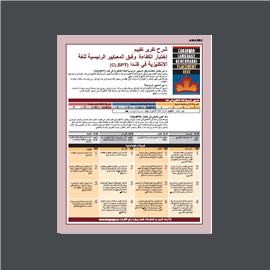
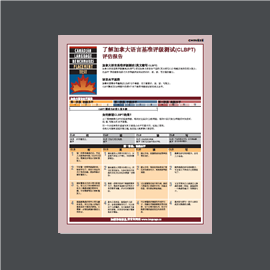
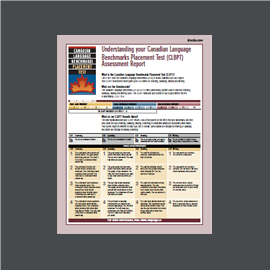
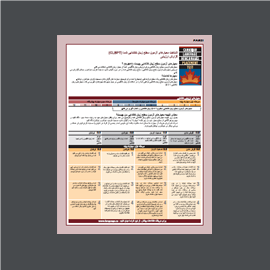

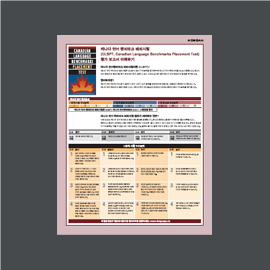
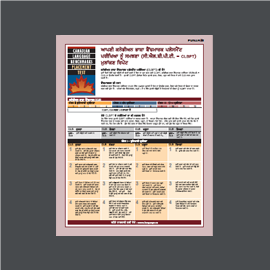
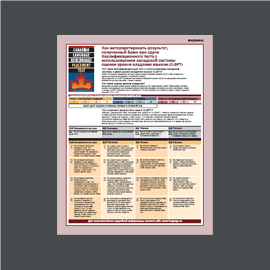
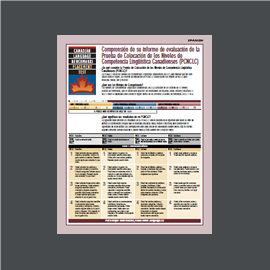
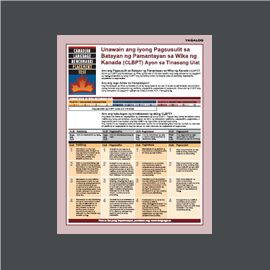
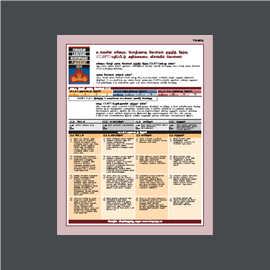
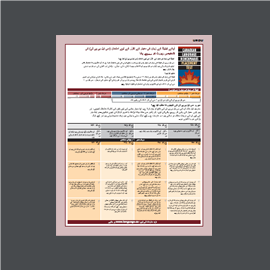

Below are some videos that give clients more information about their assessment and free language training in Canada. You can share the videos with your clients in the language they prefer. You can play them directly from our website, or you can add the videos to your own website for easy client access.
Link: https://vimeo.com/690543933
Embed code:
<iframe src=”https://player.vimeo.com/video/690543933?h=eeaec56d8c” width=”640″ height=”360″ frameborder=”0″ allow=”autoplay; fullscreen; picture-in-picture” allowfullscreen></iframe>
Link: https://vimeo.com/690543479
Embed code:
<iframe src=”https://player.vimeo.com/video/690543479?h=d160f6419a” width=”640″ height=”360″ frameborder=”0″ allow=”autoplay; fullscreen; picture-in-picture” allowfullscreen></iframe>


